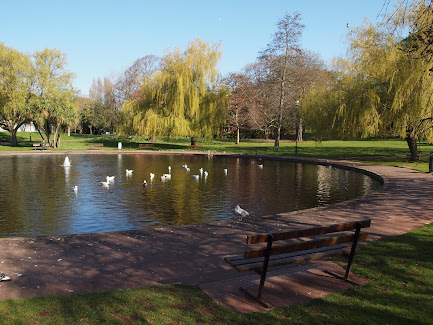I was born, and brought up, in Paignton, one of the three towns that make up Torbay, and, despite leaving in 1968, I have a strong attachment to my roots in South Devon. Unfortunately, I get few opportunities to visit but, very close to where I live currently, in Berkhamsted, there is a patch of flowers (see below) that instantly brings back memories from over fifty years ago.
Red valerian is a very common plant in the south west, being
a widely-dispersed introduction from its native Mediterranean region – appropriate,
given that Torbay prides itself on bring the English Riviera. It probably
arrived as a garden plant and is described by Clapham Tutin and Warburg [1] as
being ”abundantly naturalised on old walls, cliffs, etc. particularly in the
south and west.” It certainly has the ability to thrive where conditions look
unsuitable for plant life and its establishment can be a threat to the fabric
of old buildings [2].
My recollection of red valerian is the strong colour combinations that its pink flowers and green leaves make with the red sandstone that is the underlying rock of the central part of Torbay and which was used extensively for building construction. Technically described as a sandstone breccia conglomerate, this rock, exposed at Roundham Head, for example (see below), has been used in building houses and walls in Paignton since mediaeval times [3]. I lived in Polsham Park (the cul-de-sac road), part of the Polsham Park Estate designed by W.G.Goudrey and George Soudron Bridgman, and constructed in the last decade of the Nineteenth Century [3]. This was 50 years after the building boom in Torquay, where many villas were in an Italianate style, to reflect houses of the Mediterranean Riviera.
The buildings of the Polsham Park Estate were dressed in brick – ours were cream in colour – but the sandstone was unforuately suject to weathering, as anyone looking at Roundham Head, and other coastal promontories, readily appreciates. As our house had a verandah, one of the jobs that I helped with was the sweeping up of the red dust that accumulated on the tiles (red, of course) that were used as flooring. Nowadays, the appearance of many of the houses has been altered by the extensive use of PVC replacement windows, and roofing other than slate, the Conservation Report [3] stating that “almost overwhelmingly the workmanship is inferior in design and materials: artificial slate and PVC glazing are almost universal replacements.” Two recent images of houses on the Estate are shown below:
When I lived in this area of Paignton, it was little changed
from its original condition, but that wasn’t important to me. What I enjoyed,
was being able to run along Polsham Park (the road) to Victoria Park (the
entrance to which is shown below) where I could play on the swings, slide and
roundabouts, run around on the “pitches”, or go at top speed along the path by
the railway line to exit within easy walking distance of the railway station, there to
indulge in my favourite pastime of trainspotting. Much of the park was
completed in 1894, with the boating pond (see below in a separate image), where
I sailed my elderly, re-painted yacht, completed in 1895 [3]. The “pitches”
next to the main road to the west were previously the Victoria Nurseries and
were added to the Park in the first half of the twentieth Century.
None of this was known to me either, and which child would be interested in such things? Now that I am much older, and enjoy nostalgia, it is all fascinating to discover the history of what was so familiar in the late 1950s and early 1960s. Certainly, the combination of red valerian and red sandstone remain powerful triggers for memories of the joys of childhood and an appreciation of the “respectable” part of the town that was once my home.
[1] A.R.Clapham, T.G.Tutin and E.F.Warburg (1959) Excursion Flora of the British Isles. Cambridge, Cambridge University Press.
[2] R. Motti, G. Bonanomi and A. Stinca (2021) Biodeteriogens at a southern Italian Heritage site: Analysis and management of vascular flora on the walls of Villa Rufalo. International Biodeterioration & Biodegradation 162 https://doi.org/10.1016/j.ibiod.2021.105252
[3] https://www.torbay.gov.uk/media/7583/polsham-caa.pdf







